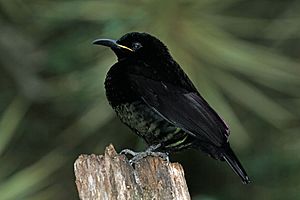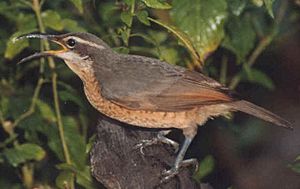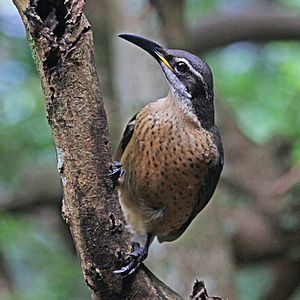Victoria's riflebird facts for kids
Quick facts for kids Victoria's riflebird |
|
|---|---|
 |
|
| Male in Queensland | |
 |
|
| Female | |
| Conservation status | |
| Scientific classification | |
| Genus: |
Lophorina
|
| Species: |
victoriae
|
| Synonyms | |
|
Ptiloris victoriae |
|
The Victoria's riflebird (scientific name: Lophorina victoriae) is a special type of bird-of-paradise. The Yidiny people call it duwuduwu. This bird lives only in the Atherton Tableland area of northeastern Queensland, Australia. It stays there all year long.
Contents
Discovering the Victoria's Riflebird
A scientist named John Macgillivray found the Victoria's riflebird in 1848. He found it for another famous scientist, John Gould. The bird is named after Queen Victoria of the United Kingdom.
The name "riflebird" comes from how the bird looks. Its black, velvety feathers remind people of the uniforms worn by the British Army's Rifle Brigade.
What Does It Look Like?
The Victoria's riflebird is the smallest of all riflebirds. It measures about 23 to 25 centimeters (9 to 10 inches) long.
Male Victoria's Riflebird
Male birds are very colorful. Their feathers shine with a purple color. This color changes to blue-green on their heads. On their lower chest, the feathers look more bronze.
Their throat is a deep, velvety black. In the middle of their throat, they have a bright triangle patch. This patch shines with metallic green and blue colors.
Female Victoria's Riflebird
Female Victoria's riflebirds look different from the males. They have a pale stripe above their eyes, like an eyebrow. Their tummy area is a light, creamy color. It also has faint brown stripes across it.
How They Behave
Courtship and Reproduction
When a male riflebird wants to attract a female, he performs a special dance. He raises the feathers on his throat and sides. This makes the bright colors of his feathers stand out. He does this in the sunlight that shines through the rainforest trees.
He also curves his round wings above his body. Then, he tilts his head back to show off his chin and throat. He moves from side to side in a way that looks almost like a robot.
The female bird hears the male's call, which sounds like a raspy 'yaars'. As he dances, his call becomes softer and more like a tune. This helps to attract her to his display spot.
When the female comes closer, the two birds face each other. Each bird then raises and moves its wings forward one after the other. They do this faster and faster. Finally, the male wraps his wings around the female. This is how they mate.
What They Eat
Victoria's riflebirds eat insects. They also enjoy eating fruits from trees. They are clever about eating fruit. They hold the fruit with one foot and use their beak to peel off the skin before eating it.
Conservation Status
The Victoria's riflebird is a common bird in the areas where it lives. Because of this, it is listed as "Least Concern" on the IUCN Red List of Threatened Species. This means it is not currently in danger of disappearing. It is also listed on Appendix II of CITES, which helps control trade of certain animals.
See also
 In Spanish: Ave del Paraíso de Victoria para niños
In Spanish: Ave del Paraíso de Victoria para niños



